Morikami
Museum & Japanese Gardens - Delray Beach, FL
Pictures & visitor information from a
trip to the Morikami Museum & Japanese Gardens located in Palm Beach County
Florida.
 Home |
 Next |
 Last |
Page 1 of 6
 Morikami & AOS Sign |
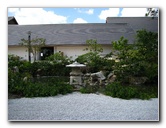 |
 Waterfall & Pond |
| The Morikami
Museum & Japanese Gardens are located at 4000 Morikami Park Road,
Delray Beach FL 33446. Visitors are welcome Tuesday through Sunday from 10 am to 5 pm. Morikami is closed every Monday and also on major national holidays. The price of admission is $10 for adults, $9 for senior citizens, $6 for children (age 6-17), and $6 for college students with a valid ID card. The staff can be reached by phone at 561-495-0233 or by fax at 561-499-2557. So far we've visited the Morikami Museum & Japanese Gardens twice. We went a second time to take advantage of Bank of America's "Museums On Us" program which grants BOA credit or debit card holders free access to over 70 museums in the US. |
||
 Front Entrance |
 Japanese Stone Statue |
 Tea House Display |
|
The Morikami Museum was opened in 1977 to preserve the history of the Yamato farming colony, which was composed of farmers from Miyazu Japan and led by Jo Sakai. The community was formed in 1904 and survived until the 1920's. George Sukeji Morikami was the colony's only resident who chose to remain in what is now northern Boca Raton. He worked as a farmer and fruit & vegetable wholesaler until the mid 1970's when George, now in his 80's, gifted his land to Palm Beach County. His wish was for the land to become a recreational area that would also preserve the history of the Yamato Colony. |
||
 Seishin-An - Tea House |
 Japanese Creative Prints |
 Japanese Garden |
| The original museum
building, known as "Yamato Kan", was constructed to resemble a Japanese
villa with a dry garden in the central courtyard, and has exhibits in each
of the rooms that illuminate the colony's history.
The new building, erected in 1993, features classrooms, a museum gift shop, a cafe, a Japanese courtyard garden, a scenic lakeside terrace, a 225 seat theater, a Japanese tea house replica, a library, exhibition galleries, and 1000's of Japanese art objects & cultural artifacts. |
||
 Gardens Entrance |
 |
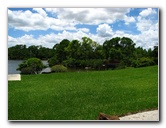 Lush Green Grass |
| We really enjoyed
learning about the history of the Yamato colony and Japanese culture, but
our favorite thing to do at Morikami is explore the two hundred acres of
picturesque grounds.
Some of the highlights of walking through the gardens are the waterfalls, the Japanese stone lanterns, the shallow creeks, the "Deer Chaser", the nature trails, the wooden bridges, the Bonsai tree collection, the bamboo groves, the peaceful lakes and the wildlife. There are park benches and drinking water dispensers conveniently located along the pathways to ensure an enjoyable experience for visitors of any ability level. |
||
 Peaceful Lake |
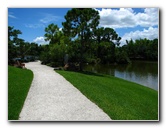 Gravel Walkway |
 Wooden Bridge |
|
The variety of gardens contained within Morikami's perimeter explore Asian gardening concepts from the 9th century through the early 20th. These include the Shinden Garden (Heian Period 9th-12th centuries), the Paradise Garden (Kamakura & early Muromachi periods 13-14th centuries), the Early Rock Garden (early Muromachi period 14th century), the Karesansui Late Rock Garden (late Muromachi to early Edo periods 16th-17th centuries), the Hiraniwa Flat Garen (Edo Period 17th-18th centuries) and the Modern Romantic Garden (Meiji Period lat 19th to early 20th centuries). |
||
 |
 |
 Shinden Garden |
| It takes a quiet footstep and a keen eye to spot some of the wildlife that inhabits the Morikami Gardens. So far in our two visits, we've seen a marsh hare, several green Iguanas, Japanese Koi fish, Great Blue Herons, Boat Tailed Grackles, Florida Cooter turtles, Red Bellied turtles, Anhinga "Snake Birds", Northern Curly Tailed lizards, and Anole lizards. | ||
 Violet Flowers |
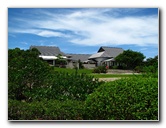 Morikami Museum Building |
 |
| The Morikami Museum & Gardens are a great place to visit any day of the year but they also put on a variety of special events such as the "Sushi & Stroll Summer Walks", the annual Hatsume Fair, the Origami Extravaganza, a Children's Day, a Mother's Day celebration, photography workshops, Garden "Walkshops" with Hoichi Kurisu, a "Katagami" Japanese stenciling workshop, "Sado" Japanese tea ceremony demonstrations, the Bon Festival, "Ikebana" flower arrangement classes, the "Oshogatsu" Japanese New Year celebration, docent educational classes, and guest speaker lectures. | ||
 |
 Japanese Paper Lanterns |
 |
| If you enjoyed your visit to the Morikami Museum & Gardens and you live in the South Florida area, consider purchasing an annual membership. Members enjoy unlimited free admission to this popular attraction and also free admission to the festivals. The fees to become a member range from $30 for a student, all the way up to $1,500 for a "Wisdom Ring" membership. Most families interested in becoming members will probably choose the $80 "Daruma" level membership which allows unlimited free access for two named adults and their children or grandchildren. | ||
 Morikami Falls |
 Scenic Waterfalls |
 |
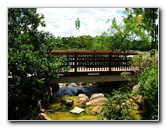 |
 |
 |
 |
 |
 |
 |
 |
 |
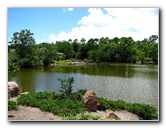 |
 |
 |
 |
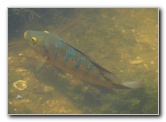 Colorful Freshwater Fish |
 |
 Green Iguana Walking |
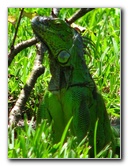 |
 "Iguana Iguana" Species |
|
During our visit, I filmed a few short video clips of the scenic surroundings and the wildlife that resides at the Morikami Museum & Japanese Gardens. It is encoded in the WMV (Windows Media Video) format, runs about 2 minutes long and has a file size of 17 mb (megabytes). To view the movie, click on the link below. To download the movie to your hard drive, right-click and choose "Save Target As" or "Save Link As". |
||
| Morikami Museum & Japanese Gardens Video Clip | ||
 Home |
 Next |
 Last |
